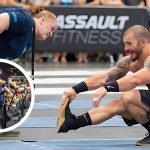15 Dumb Muscle-Building Mistakes Sabotaging Your Gains (FIX THESE!)
We may receive a commission from our affiliate links at no additional cost to you. See disclosures page.
Are you sabotaging your workouts without realizing it?
These 15 common fitness mistakes, from respected Youtuber Sean Nalewanyl, might be holding you back from reaching your bodybuilding goals.
Discover the simple adjustments that could lead to massive gains. Learn why chasing that satisfying “pump” isn’t always the answer and why feeling exhausted doesn’t guarantee progress.
Who is Sean Nalewanyl?
Sean Nalewanyj is a well-respected figure in the fitness community, known for his straightforward and science-backed approach to bodybuilding and fitness.
With years of experience under his belt, Sean has established himself as a credible source of information, especially for those looking to make real, natural gains in muscle and strength.
He’s not just a fitness coach; he’s an author and entrepreneur who has dedicated a significant portion of his career to debunking fitness myths and promoting evidence-based training and nutritional strategies.
On with the 15 Muscle-building mistakes:
Centering workouts around getting a pump
While a pump feels satisfying, it isnt a significant driver of muscle hypertrophy by itself. Focusing on getting a pump might not lead to effective muscle building.
Focus on Progressive Overload: Instead of centering workouts around getting a pump, prioritize progressive overload to continuously challenge your muscles, leading to growth.
Using fatigue as a gauge for training success
Fatigue is a byproduct of intense exercise but not a direct stimulator of muscle growth. Feeling exhausted doesnt necessarily equate to productive muscle-building activity.
Measure Progress with Performance: Instead of using fatigue as a gauge for training success, measure progress by improvements in performance, such as lifting heavier weights or performing more reps.
Relying on muscle soreness
Muscle soreness indicates some level of tissue damage but is not a direct driver of muscle growth. Effective muscle building can occur without extreme soreness.
Understand Soreness: Rather than relying on muscle soreness as an indicator of a good workout, understand that soreness can vary and is not directly correlated with muscle growth.
Not training hard enough
Not pushing close to true muscular failure on your sets can hinder muscle growth. Intensity and reaching close to failure are crucial for stimulating significant growth.
Train with Intensity: Increase the intensity of your workouts by training closer to muscular failure within safe limits to stimulate muscle growth effectively.
Not tracking workouts
Progress in muscle building comes from progressively overloading the muscles over time, and tracking workouts is essential for monitoring and ensuring progress.
Track Your Workouts: Keep a detailed log of your workouts to track progress and ensure you’re consistently applying the principle of progressive overload.
Constantly switching up workouts
Frequent changes in workout routines can make it hard to track progress and overload effectively. Consistency in exercises is key to mastering technique and achieving hypertrophy.
Maintain a Consistent Routine: Stick to a consistent workout routine to allow for accurate tracking of progress and mastery of exercises, rather than frequently changing your routine.
Improper exercise selection
Choosing exercises without understanding the specific muscle functions can lead to ineffective training. Its important to select exercises that appropriately target the desired muscle groups.
Select Exercises Wisely: Choose exercises based on their ability to effectively target the desired muscle groups, considering the muscle’s function and the exercise’s ability to apply tension.
Over-emphasizing certain muscle groups
Focusing too much on showy muscles like the chest and biceps can neglect other important muscle groups, leading to imbalances and less optimal physique development.
Balance Your Training: Ensure a balanced approach to training all muscle groups to avoid imbalances and create a proportionate physique.
Creating instability during lifts
Using unstable surfaces or performing off-balanced exercises reduces the force you can apply and hampers effective muscle tension and growth.
Stabilize Your Lifts: Perform exercises in a stable environment to maximize the force you can apply and the tension on the muscles, avoiding unnecessary instability.
Ego lifting
Sacrificing form for heavier weights not only risks injury but also reduces the effectiveness of the exercise on the target muscle group.
Prioritize Proper Form: Focus on lifting with proper form to maximize muscle engagement and minimize the risk of injury, avoiding ego lifting.
Being overly strict with form
While good form is essential, being too rigid can reduce the natural movement and effectiveness of exercises. A balance between solid technique and natural movement is ideal.
Find the Right Balance in Form: Aim for a balance between strict form and allowing natural movement during exercises to effectively target the muscles without being overly rigid.
Performing too much high rep work
Very high rep sets can lead to excessive systemic fatigue, which may become the limiting factor rather than muscle failure, making them less efficient for growth.
Optimize Rep Ranges: Focus on moderate rep ranges (e.g., 6-12 reps) that allow for significant tension and intensity, rather than excessively high rep work that leads to undue fatigue.
Not resting long enough between sets
Insufficient rest can impair recovery and reduce the effectiveness of subsequent sets, undermining muscle growth efforts.
Rest Appropriately Between Sets: Allow sufficient rest between sets to fully recover, enabling you to maintain the intensity and quality of your workouts.
Performing pre-workout cardio
Doing intense cardio before weights can lead to systemic fatigue, reducing the effectiveness of muscle-building efforts during the workout.
Separate Cardio and Strength Sessions: If cardio is part of your routine, consider doing it post-workout or on separate days to prevent it from compromising your strength training sessions.
Copying routines of enhanced bodybuilders
Routines designed for or by individuals using performance-enhancing drugs may not be suitable for natural athletes due to different recovery and growth mechanisms.
Follow Evidence-Based Routines: Choose workout routines based on proven principles for natural lifters, avoiding copying the routines of enhanced bodybuilders, which may not be suitable for your context.




